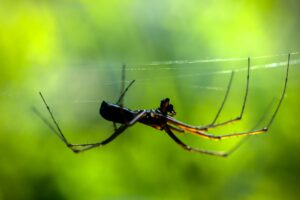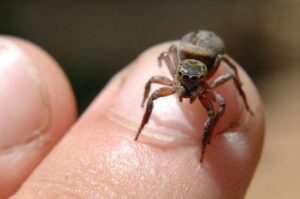What Attracts Mosquitoes to People
Swimming pools, barbecues, and fishing holes have us dreaming about the lazy days of summer, but playing in the great outdoors makes us targets for mosquitoes, and they’re always looking for their next meal. Mosquitoes are attracted to people — and we’re all on the menu.
What’s the Attraction?
When people (and animals) breathe, we exhale carbon dioxide (CO2). CO2 is a receptor that allows mosquitoes to detect people by way of skin odor, bacteria, perspiration, and body heat.
Have you ever noticed how mosquitoes follow you when you’re working or playing outside? The attraction to warm and sweaty human skin is irresistible. (Pregnant women are particularly “tasty” because they have warmer bodies. Warmth is a draw for female mosquitoes that are searching for blood to fertilize their own eggs).
Environment, perfumes and other artificial scents, natural fragrances, moisturizers (mostly containing lactic acid), food, and stagnant water are known to attract mosquitoes. Even dark-colored clothing lures these biting bugs to your body.
Science Lesson
Mosquitoes have keen taste sensors that can detect carbon dioxide from at least 50 to 100 feet. As female mosquitoes get closer to the source, they’re searching for skin odors like ammonia, bacteria, or lactic acid. Mosquitoes are particularly fond of flying around our faces because we exhale CO2 through the nose and mouth.
Female mosquitoes do the biting — they want your blood to fertilize and feed their eggs. When she finds her target, the female uses taste sensors (in her legs) to find just the right spot and then … bite! Male mosquitoes don’t typically bite people and animals — they feed on nectar.
But Why Me?
If it seems that you’re more of a mosquito magnet than, say, your spouse or kids, you may not be imagining it. The chemistry of mosquito attraction is different for different people — meaning some people are more of a target. Theories include blood type, the kind of foods you eat, soap and deodorant fragrances, perfumes, wearable colors, and one’s molecular makeup. Another thought is that people who eat a lot of sugar have “sweet meat.”
Mosquito Bite Concerns
Besides the uncomfortable annoyance of itchy, red, and swelling bites, mosquitoes can transmit diseases, like malaria, dengue, and yellow fever. Mosquito-borne diseases are most common in tropical climates.
Most mosquito bite symptoms go away after a few days, but talk to your doctor if you develop a fever, nausea, and body aches within the following two weeks after getting bitten.
Bug Off, Mosquitoes!
With all types of products on the market, you may be able to keep most of those biting skeeters away from you and your family. Apply commercial or homemade bug repellents as needed.
Natural and chemical scents repel mosquitoes, too. Insect repellent with picaridin or DEET is effective. The smell of citronella isn’t very pleasant, but the product does ward off bugs. Mosquito-repelling plants for the backyard include lavender, eucalyptus, peppermint, marigolds, lemongrass, and chrysanthemums.
Cleaning up the backyard is a good idea, too, because female mosquitoes like to nest in quiet, wet places.
- Remove trash and rake brush piles where females can build nests.
- Dump stagnant water in kiddie pools, birdbaths, and pet water bowls.
- Clean clogged gutters, cover rain barrels, and shake out patio furniture cushions, tarps, and storage boxes after rainfall.
- Set up a bat box — bats are natural predators of those tasty mosquitoes.
Stay indoors at dawn and dusk when mosquitoes are most likely out to forage. If you must be out to walk the dog, catch lightning bugs, or play softball, stay away from grassy and wooded areas.
Living, breathing beings will bring mosquitoes to the table. Hiring a professional company to exterminate mosquitoes is one good way to eliminate — or at least, reduce — the problem. Or you can wear a protective snowsuit from head to toe … in the summer heat … yes, that’ll do it too.

Student Scholarships
Every year Thrive Pest Control hosts an essay contest and the reward is a 1-year scholarship at a 4-year university in the United States. This blog post is one of those scholarships.

How to Pick a Pest Control Company — Aiden’s Student Essay
Home is where you feel safe, secure, and where you live your life. Not only is your house a home to you, but it is also the home to the years of memories you have made there

Which spiders in the U.S. are venomous? — Gabriela’s Student Essay
Which Spiders in The U.S Are Venomous? There are three popular and known poisonous spiders in the United States – the black widow, the hobo,

Signs of raccoons terrorizing your home — Denver’s student essay
Signs of Raccoons Terrorizing Your Home “What’s that scratching noise I’m hearing in my attic?” “Why are my garbage bins knocked down every morning?” “Where

Will Pest Control Get Rid of Spiders — Joe’s student essay
Will Pest Control Get Rid of Spiders? When asked if pest control gets rid of spiders most people’s immediate answer would be, “I don’t know,

Where does pest control spray in apartments — Sarahi’s student essay
Where Does Pest Control Spray In Apartments? When the situation involves bugs, rodents, and even insects, there can be a variety of places where pest

Where does pest control spray in apartments — Aidan’s student essay
Where Does Pest Control Spray In Apartments? The home exists as a place of comfort and safety. The best option for financially independent young adults
